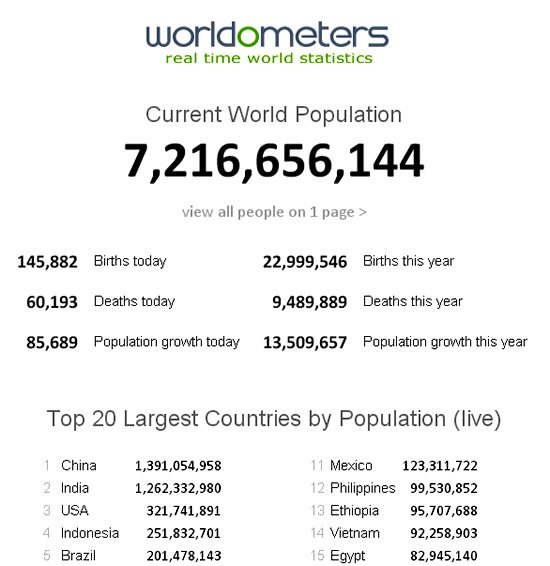
Image Source: http://img.gawkerassets.com
In this lesson we look at Exponential Growth of Populations.
Exponential growth involves increases starting off as reasonably small, and then dramatically increasing at a faster and faster rate.
The world’s accelerating population growth is a major concern in terms of how our planet can feed and provide fuel for the current 7.2 billion plus people who currently live in our world.
In addition to the explosion of humans on our own planet, Animals and Bacteria also increase exponentially.
The following video shows how Bacteria divide and multiply exponentially.
Human Population Growth
By the year 2000, there were around 10 times more people on Earth than there were just 300 years ago in 1700.
WORLD POPULATION
Year —– Population
1700 —– 600 000 000
1800 —– 900 000 000
1900 —- 1 500,000 000
2000 —- 6 000,000 000
2011 —- 7 000,000 000
On a graph, the increase looks like this:
Image Source: http://www.pfaf.org
Here is an excellent two and a half minute video which shows the history of the world’s population increase:
Increasing Life Expectancy

Image Source: http://elimfamilychurch-eastbourne.org.uk
The death rate has reduced, and people now live a lot longer and many more children are produced and live longer.
In 1960 the average age of death was 53 years old, but now it is around 75 years old.
The increase in health and life expectancy was historically unevenly spread throughout the world.
But over the last 200 years, Long Life and Good Health have generally increased throughout most of the world, and this has contributed to our exponentially huge population increase.
The following four minute Swedish video shows what has happened over the last 200 years.
Population Growth Equation

Image Copyright 2013 by Passy’s World of Mathematics
Population Growth follows Mathematics which involves exponents.
Exponential increases start off slow, but then sharply increase to a massive explosion in size, just like the power of a rocket engine igniting at take off.
An exponents formula, similar to the one used on compound growth for superannuation and interest bearing investments, can be used to estimate the Populations of Humans, Animals, and Bacteria.

Image Copyright 2013 by Passy’s World of Mathematics
This Equation involves the exponents of Rate x Time, and this is why Exponential patterns of increase in Populations occur.
Find out more about this equation at the following link:
Click here for Population Growth Mathematical Equations
There is a set of Population Growth fully worked example Maths Problems at the following link:
Click here for Population Growth Example Maths Questions
World Population Growth
Although Total Population is dramatically increasing, the actual Percentage Rate of world’s population growth is slowing down.
Throughout the 1960s, the world’s population was growing at a rate of about 2% per year.
By 1990, that rate was down to 1.5%, and by the year 2015, it’s estimated that it will drop down to 1%.
Currently each second, 5 people are born, and 2 die, which means that each second of the day we get an extra three people on the planet.
There is an excellent real time Population meter which ticks over continuously, at the following link:
http://www.worldometers.info/world-population/
Family planning initiatives, an ageing population, and the effects of epidemic diseases such as AIDS, are some of the factors behind this rate decrease.
Even at these very low rates of population growth, the population increase numbers are still staggering.
By 2015, despite a low expected 1% growth rate, experts estimated there would be 7 billion people on the planet.
We actually reached 7 billion people four years earlier than this in 2011.
By 2050, there may be as many as 10 billion people living on Planet Earth.
Can the planet support this population and when will we reach the limit of our resources?
Space on the planet is not the problem, as 7 billion people standing shoulder to shoulder would only occupy the area of the city of Los Angeles.
There are already 23 megacities around the world where people live very large numbers.
The main problem is not space, but an inbalance in food and fuel, with 5% of the earth’s population consuming 23% of the world’s energy.
Or in other words 1/20th of the world’s people using up 1/4 of the energy.
13% of the world does not have clean drinking water, and 40% do not have adequate sanitation and sewerage treatment.
The following video is about the science of overpopulation: how it has occurred and what it means to our future.
The following video shows that Population Growth is not the key part of our problems.
War and Poverty are far bigger problems, than our overpopulation.
The Future of Our Planet
The following one hour video documentary shows that extreme poverty has decreased, especially in Asia.
In fact, for the first time on our history, poverty could be totally eliminated.
Although it is one hour long, it is definitely worth watching.
Related Items
Why Exponents and Indices are Important
Subscribe
If you enjoyed this lesson, why not get a free subscription to our website.
You can then receive notifications of new pages directly to your email address.
Go to the subscribe area on the right hand sidebar, fill in your email address and then click the “Subscribe” button.
To find out exactly how free subscription works, click the following link:
If you would like to submit an idea for an article, or be a guest writer on our website, then please email us at the hotmail address shown in the right hand side bar of this page.
Feel free to link to any of our Lessons, share them on social networking sites, or use them on Learning Management Systems in Schools.
Like Us on Facebook
Our Facebook page has many additional items which are not posted to this website.
These include items of mathematical interest, funny math pictures and cartoons, as well as occassional glimpses into the personal life of “Passy”.
Check it out at the following link:
https://www.facebook.com/PassysWorldOfMathematics
While you are there, LIKE the page so you can receive our FB updates to your Facebook News Feed.
Help Passy’s World Grow
Each day Passy’s World provides hundreds of people with mathematics lessons free of charge.
Help us to maintain this free service and keep it growing.
Donate any amount from $2 upwards through PayPal by clicking the PayPal image below. Thank you!
PayPal does accept Credit Cards, but you will have to supply an email address and password so that PayPal can create a PayPal account for you to process the transaction through. There will be no processing fee charged to you by this action, as PayPal deducts a fee from your donation before it reaches Passy’s World.
Enjoy,
Passy



